南极臭氧空洞、紫外线辐射和丛林大火
IF 2
4区 地球科学
Q3 ENVIRONMENTAL SCIENCES
引用次数: 0
摘要
在20世纪80年代,英国南极科学家(Farman et al. 1985)发现了南极洲上空的臭氧层空洞,我们现在熟悉了春季臭氧消耗延伸到大陆边缘以外的图像(图1a)。南极最大的臭氧空洞发生在2006年(图1b),但近年来已经开始明显恢复,预计到2066年臭氧柱总量将恢复到1980年的水平(WMO 2022)。然而,仍有理由担心南极洲紫外线照射的时间和程度,以及野火等气候变化介导的事件如何危及臭氧恢复。臭氧层保护地球表面免受有害的UV-B辐射。最近的报告表明,在最大臭氧消耗期间(1990-2020年),Palmer站(64°S)的最大春季紫外线指数与1970年代初测量的臭氧空洞前时代相比增加了2.5倍。尽管南极洲的太阳角度要低得多,但帕尔默站春季的最大紫外线指数有时会超过亚热带地区夏季的最大值(圣地亚哥,加利福尼亚,32°N;Bernard et al. 2022;环境影响评估小组(已出版)。南极臭氧消耗通常在9月至10月达到高峰,那时大多数南极陆地植被和土壤生物群将被冻结、休眠,并有望被积雪覆盖。同样,许多海洋生物将受到海冰覆盖的保护,尽管一些海豹和鸟类可能在这个时候在冰上繁殖。通常到夏季到来时,臭氧层已经恢复(见图1c中的白线)。然而,在过去3年中,臭氧消耗范围广泛(图1b)且持续时间长,一直延续到初夏(如2022年;见图1c中的黑线)。自2019年以来,60-90°S纬度地区11月至12月的臭氧柱总深度是自20世纪80年代有记录以来的最低水平(NASA 2023)。从生物学家的角度来看,12月初的臭氧消耗更令人担忧,因为这更接近冬至,这意味着所有的太阳辐射都更高,包括紫外线指数。紫外线指数的峰值与融雪和植被的出现以及夏初的繁殖期一致,这是特别值得关注的,因为更多的生物群可能会暴露在这种较高的UV- b辐射下。对某些生物来说,这种接触也可能发生在其生命周期中较脆弱的时期。正如联合国环境规划署环境影响评估小组最新报告(Barnes et al. 2023;环境影响评估小组(已出版)。《蒙特利尔议定书》是一项极为成功的环境条约。由于该条约,消耗臭氧层化合物(如氟氯化碳;氯氟烃)已经得到控制,预计到2066年臭氧层将恢复(WMO 2022)。根据《蒙特利尔议定书》及其2016年基加利修正案采取的行动也有助于减少温室气体排放和减缓全球气温上升,方法是用不会导致气候强迫的化合物取代导致温室气体排放的氟氯化碳。据估计,这已在中纬度地区防止了至少0.5-1.0°C的变暖,并在北极地区防止了超过1.0°C的变暖(WMO 2022;环境影响评估小组(已出版)。但我们不能自满。近年来观测到的延长的臭氧消耗可能在一定程度上因气候变化的影响而加剧。最近的两个大型臭氧空洞受到不同事件的影响:2019-2020年澳大利亚黑夏森林大火和2021年La Soufriere火山喷发(Yook et al. 2022)。研究表明,澳大利亚大面积的野火向平流层注入了能够消耗臭氧的气溶胶(Damany et al. 2022;Yook et al. 2022),并可能导致2020年臭氧空洞面积增大(图1b;Solomon et al. 2023)。不像臭氧的原始原因doi:10.1017/S0954102023000081本文章由计算机程序翻译,如有差异,请以英文原文为准。
The Antarctic ozone hole, ultraviolet radiation and bushfires
In the 1980s, British Antarctic scientists (Farman et al. 1985) discovered the hole in the ozone layer over Antarctica, and we are now familiar with images of springtime ozone depletion extending beyond the continental margins (Fig. 1a). The largest Antarctic ozone hole occurred in 2006 (Fig. 1b), but in recent years recovery has started to become apparent, with the total column ozone predicted to return to 1980 levels by 2066 (WMO 2022). However, there is still reason to be concerned about the timing and extent of ultraviolet (UV) radiation exposure in Antarctica, as well as how ozone recovery may be jeopardized by climate change-mediated events such as wildfires. The ozone layer protects the Earth's surface from damaging UV-B radiation. Recent reports demonstrate that over the period of maximum ozone depletion (1990–2020) the maximum spring UV index at Palmer Station (64°S) has increased by 2.5 times compared to the pre-ozone hole era as measured in the early 1970s. Despite the solar angle being much lower in Antarctica, the maximum UV index at Palmer Station in spring can now sometimes exceed that experienced in summer in subtropical regions (San Diego, CA, 32°N; Bernard et al. 2022; Environmental Effects Assessment Panel in press). Antarctic ozone depletion generally peaks between September and October, when most Antarctic terrestrial vegetation and soil biota will be frozen, dormant and hopefully protected under snow cover. Similarly, much marine life will be protected by sea-ice cover, although some seals and birds might be breeding on the ice at this time. Usually by the time summer arrives the ozone layer has recovered (see white lines in Fig. 1c). However, for the past 3 years ozone depletion has been extensive (Fig. 1b) and long-lasting, extending into early summer (e.g. 2022; see black lines in Fig. 1c). Since 2019, November–December total ozone column depth for latitudes 60–90°S have been the lowest since records began in the 1980s (NASA 2023). From a biologist's perspective, ozone depletion in early December is far more concerning, given that this is closer to the solstice, meaning that all solar radiation is higher, including the UV index. A peak in UV index coincident with snowmelt and the emergence of vegetation as well as during the peak breeding season at the start of the summer is of particular concern, as more biota are likely to be exposed to this higher incident UV-B radiation. For some organisms, such exposure may also occur at a more vulnerable time in their life cycles. The effects of climate change through earlier snowmelt and heatwaves (Robinson et al. 2020, Environmental Effects Assessment Panel in press) is likely to be enhancing the spring and summer UV exposure of Antarctic organisms, as noted in the latest United Nations Environment Program Environmental Effects Assessment Panel report (Barnes et al. 2023; Environmental Effects Assessment Panel in press). The Montreal Protocol is an extremely successful environmental treaty. As a result of this treaty, the release of ozone-depleting compounds (e.g. chlorofluorocarbons; CFCs) has been controlled, and the ozone layer is predicted to recover by 2066 (WMO 2022). Actions taken due to the Montreal Protocol and its Kigali 2016 amendment have also contributed to reducing greenhouse gas emissions and slowing global temperature increases through the substitution of those CFCs that contributed to greenhouse gas emissions with compounds that do not contribute to climate forcing. It is estimated that this has prevented at least 0.5–1.0°C of warming in the mid-latitudes and prevented more than 1.0°C of warming in the Arctic (WMO 2022; Environmental Effects Assessment Panel in press). But we cannot afford to be complacent. The extended ozone depletion observed in recent years may have been exacerbated in part by climate change impacts. Two of the recent large ozone holes were influenced by distinct events: the Australian Black Summer bushfires of 2019–2020 and the eruption of the La Soufriere volcano in 2021 (Yook et al. 2022). Research shows that the extensive Australian wildfires injected aerosols into the stratosphere that are capable of depleting ozone (Damany et al. 2022; Yook et al. 2022) and probably contributed to the larger ozone hole area in 2020 (Fig. 1b; Solomon et al. 2023). Unlike the original causes of ozone doi:10.1017/S0954102023000081
求助全文
通过发布文献求助,成功后即可免费获取论文全文。
去求助
来源期刊

Antarctic Science
地学-地球科学综合
CiteScore
3.60
自引率
6.20%
发文量
42
审稿时长
3 months
期刊介绍:
Antarctic Science provides a truly international forum for the broad spread of studies that increasingly characterise scientific research in the Antarctic. Whilst emphasising interdisciplinary work, the journal publishes papers from environmental management to biodiversity, from volcanoes to icebergs, and from oceanography to the upper atmosphere. No other journal covers such a wide range of Antarctic scientific studies. The journal attracts papers from all countries currently undertaking Antarctic research. It publishes both review and data papers with no limits on length, two-page short notes on technical developments and recent discoveries, and book reviews. These, together with an editorial discussing broader aspects of science, provide a rich and varied mixture of items to interest researchers in all areas of science. There are no page charges, or charges for colour, to authors publishing in the Journal. One issue each year is normally devoted to a specific theme or papers from a major meeting.
 求助内容:
求助内容: 应助结果提醒方式:
应助结果提醒方式:


